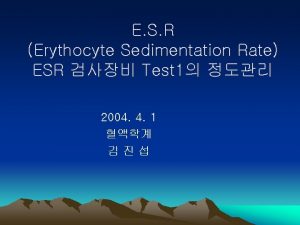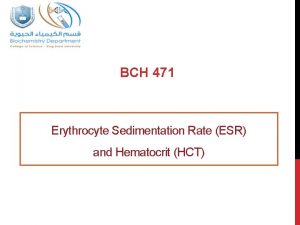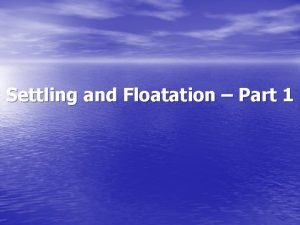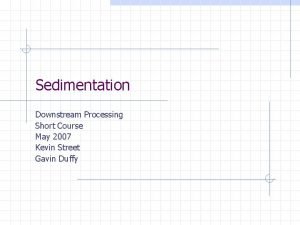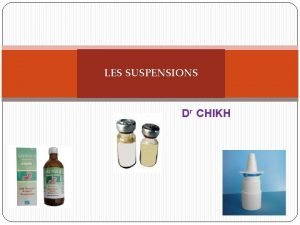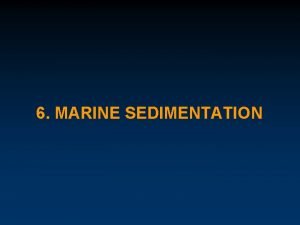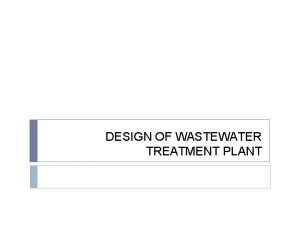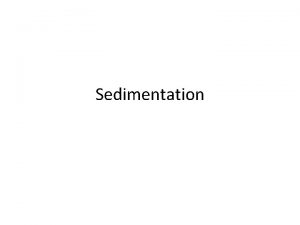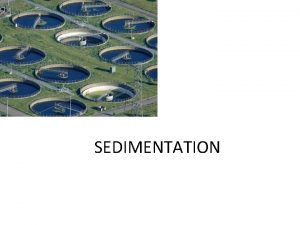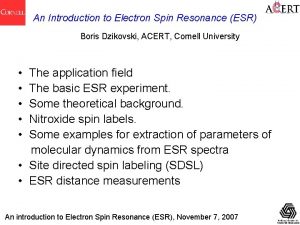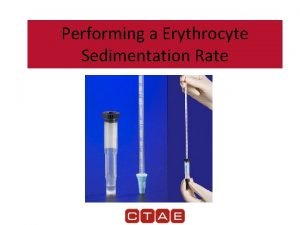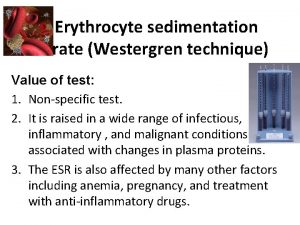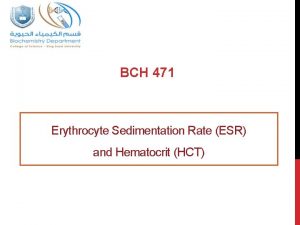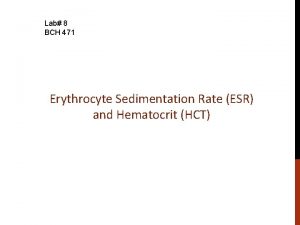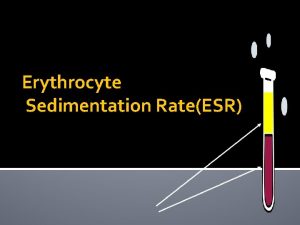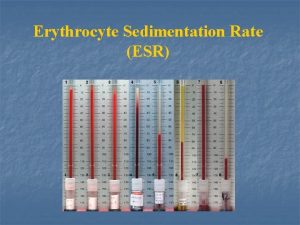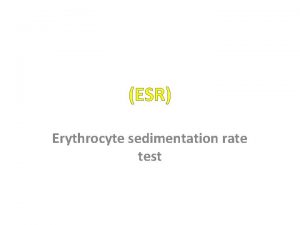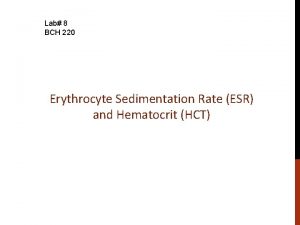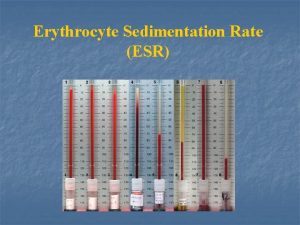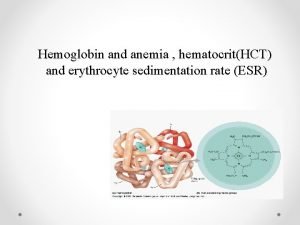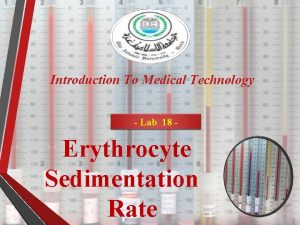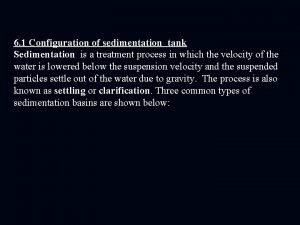CHAPTER 12 ERYTHROCYTE SEDIMENTATION RATE ESR Acknowledgements n






























- Slides: 30

CHAPTER 12: ERYTHROCYTE SEDIMENTATION RATE ( ESR )

Acknowledgements n n n n Addisa Ababa University Jimma University Hawassa University Haramaya University of Gondar American Society for Clinical Pathology Center for Disease Control and Prevention. Ethiopia

Objectives At the end of this chapter, the students will be able to: q Define ESR q Discuss the factors that affect ESR q Explain the stages in ESR q State the principle of the Westergren method of ESR determination q State the principle of the Wintrobe method of ESR determination q List the materials required to perform the ESR by Westergren and Wintrobe methods

Objectives cont’d q q q Discuss the advantages and disadvantages of the ESR determination by Westergren and Wintrobe methods Perform ESR measurement on a sample using the Westergren and Wintrobe methods List sources of error in ESR determination Indicate the normal values and the clinical implications of ESR determination Perform QC in ESR determination

Outline n n n Introduction Stages in ESR determination Methods of ESR determination Clinical significance QC in ESR determination

12. 1 Introduction i. Definition n Erythrocyte sedimentation rate is the rate of fall (sedimentation) of red cells when an anticoagulated blood is allowed to stand undisturbed for a specified period of time, usually 1 hour. The rate is expressed in mm/hr. n It is: ¨ a non specific test ¨ used as an index of the presence and extent of inflammation (the so-called 'acute phase response' ) and its response to treatment, e. g. , tuberculosis, rheumatoid arthritis.

ii. Significance of Measuring the ESR n n normal ESR can not be taken to exclude the presence of organic disease majority of acute or chronic infections and most neoplastic and degenerative diseases are associated with changes in the plasma proteins which lead to an acceleration of the sedimentation rate.

iii. Principle n The ESR is determined by filling a narrow pipette of predetermined length and bore, with well mixed anticoagulated blood and placing it in a vertical position for a set time at the end of which the distance from the top of the column to the interface between the plasma and the sedimented red cells is recorded and expressed in mm/unit time.

12. 2. Stages in ESR has three stages: i. An initial period of 10 minutes rouleaux formation takes place ii. A period of approximately 40 minutes settling or sedimentation occurs at a constant rate, and iii. A slower rate of fall (last 10 minutes) packing of the sedimented red cell column occurs. * The second stage is the most significant phase. RBCs Rouleaux

12. 3 Factors Affecting the ESR I. Effect of Plasma Proteins n The relationship between plasma proteins and rouleaux formation is the basis for measurement of ESR as a nonspecific test of inflammation and tissue damage. n Red cells possess a net negative charge (zeta potential) and when suspended in normal plasma, rouleaux formation is minimal and sedimentation is slow. Alterations in proportions and concentrations of various hydrophilic protein fractions of the plasma occur following tissue injury or in response to inflammation n

Cont’d. . Reduce the zeta potential and increase the rate of rouleaux formation and the size of the aggregates thus increasing the rate of sedimentation. ¨ The ESR shows a linear relationship with the concentration of fibrinogen and alpha and beta globulins. In most acute infections and chronic pathological processes these fractions are increased thus enhancing the ESR. ¨ Albumin which tends to counteract rouleaux formation diminishes in concentration (hypoalbuminemia) in inflammatory processes further increasing the sedimentation rate. ¨

Cont’d II. Influence of Plasma Viscosity ¨ The ESR and plasma viscosity in general increase in parallel. ¨ But plasma viscosity may increase to the extent of masking the rouleaux forming property of the plasma proteins. III. Effect of Red Cell Factors n Efficient rouleaux formation depends on normal shape and size of the red cells. n Anisocytosis and poikilocytosis will reduce the ability of the red cells to form large aggregates thus reducing the sedimentation rate.

Cont’d. . n n Anemia, by altering the ratio of red cells to plasma, encourages rouleaux formation and accelerates sedimentation. Cellular factors may affect sedimentation. Thus in iron deficiency anemia a reduction in the intrinsic ability of the red cells to sediment may compensate for the accelerating effect of an increased proportion of plasma.

Cont’d. . IV. Effect of Mechanical Influences The conditions under which the ESR is performed may influence the results. ¨ Perpendicularity of the sedimentation pipette ü slight deviations from the vertical will increase the rate of sedimentation. A 3 o inclination can increase the ESR by 30%. n Vibration ¨ vibration can reduce the ESR by retarding the rate of rouleaux formation n e. g. , centrifugation on the same table

Cont’d. . V. Effect of Temperature n Higher temperatures cause falsely elevated results ¨ By reduction in plasma viscosity ¨ Nevertheless, variation in the ambient temperature of a laboratory is unlikely to be a significant problem unless the tubes are exposed to direct sunlight.

12. 4 Determination of ESR Two basic methods n Westergreen and Wintrobe methods 12. 4. 1 The Westergreen Method This is ICSH reference method for ESR determination. Materials n Westergreen-Katz tube ¨ an open glass tube with an overall length of 300 mm and bore of 2. 5 mm. ¨ The graduated portion measures 200 mm. n Westergreen rack or stand n 30. 88 g/l tri-sodium citrate n a rubber teat or pipet filler n

Westergreen rack & tube

Westergreen rack & tube filled with blood sample

Procedure Venous blood is diluted accurately in the proportion of one volume of citrate to four volumes of blood. ü The blood may be directly collected into the citrate solution or an EDTA anticoagulated blood used. ü Mix thoroughly by gentle repeated inversion. ü ESR preparations should preferably be set up within 2 hrs of blood collection, but under extenuating circumstances may be refrigerated overnight at 4 o. C before testing. 2. A clean dry Westergren-Katz pipette is carefully filled and adjusted to the "0" mark on top. 1.

Cont’d. . 3. 4. 5. The pipet is placed in a strictly vertical position in the Westergren stand ¨ under room temperature conditions ¨ not exposed to direct sunlight and ¨ away from vibrations and draughts Allow it to stand for exactly 1 hour After 1 hour read to the nearest 1 mm the height of the clear plasma above the upper limit of the column of sedimenting red cells.

Cont’d. . Reporting ü The result is expressed as ESR = X mm/hr ü A poor delineation of the upper layer of red cells, the so-called ‘stratified sedimentation’, has been attributed to the presence of many reticulocytes.

Westergreen method Cont’d. . Advantages ¨ It more reliably reflects the clinical state ¨ is the most sensitive method for serial study of chronic diseases, e. g. , tuberculosis. Disadvantages ¨ Requires a large amount of blood. ¨ Involves dilution which may be one source of error. Normal Range: Men: 0 -15 mm/hr Women: 0 -20 mm/hr

Cont’d. . n There is a progressive increase with age as there is decline in plasma albumin concentration n ESR is increased in pregnancy as there is a decrease in plasma albumin due to: ¨ hypovolemia and ¨ an increase in concentration of globulin and fibrinogen.

12. 4. 2 The Wintrobe Method n Uses a tube closed at one end, 11 cm long with a bore of 2. 5 mm and having a graduated scale from 0 -100 mm and a special Wintrobe rack

Procedure 1. Blood is collected with EDTA in the right proportion. 2. Enough blood to fill the Wintrobe tube (approximately 1 ml) is drawn into a Pasteur pipette having a long stem. 3. The Wintrobe tube is then filled from the bottom up (so as to exclude any air -bubbles) to the "0" mark. 4. The tube is placed in the Wintrobe rack in exactly vertical position and the time is noted. 5. At the end of 1 hour the ESR is read as the length of the plasma column above the cells and is expressed as x mm/hr.

Wintrobe method cont’d Advantages n The method is: ¨ simple ¨ requires ¨ no a small amount of blood dilution required n With the same preparation, once the ESR has been read, the hematocrit value can be determined after centrifugation. n Microbilirubin determination can be made on supernatant plasma and smears of buffy coat can be made.

Wintrobe method cont’d Disadvantages n Because of the short column, it is only sensitive when the ESR is low and when the disease is in the acute stage. n Normal Range ¨ Men: 0 -7 mm/hr ¨ Women: 0 -15 mm/hr

Quality control n n Strictly adhere to SOP (timing, positioning the ESR rack, etc)! Quality control samples are commercially available Sources of error n n Improper filling of tubes Old specimen (should be performed within 2 hours of collection) Cold agglutinins can cause a falsely elevated ESR Clotted and hemolysed samples

Technical tips n n n Tube must be completely filled to the zero mark Hemolyzed specimen is not accepted There should be no air bubble Refrigerated specimens must come to room temperature for 30 minutes prior to testing ¨ refrigerated sample is used within 24 hours, if the test can not be performed within 2 hours of sample collection The ESR rack must be on a level surface and free of vibration Strictly follow SOP

Review questions 1. 2. 3. 4. 5. 6. Define the ESR What is the principle of ESR determination? What are the stages in ESR that occur in a tube filled with an appropriately diluted sample of blood? List the items required in ESR determination using the Westergren method. What is the clinical significance of measuring ESR? List at least five sources of error and their remedies in ESR determination
 Erythrocyte sedimentation rate principle
Erythrocyte sedimentation rate principle Rodak
Rodak Erythocyte sedimentation rate
Erythocyte sedimentation rate Hematocrit calculator
Hematocrit calculator Esr rate normal value
Esr rate normal value Esr blood test normal range
Esr blood test normal range Objectives of size reduction
Objectives of size reduction Example of flotation and settling
Example of flotation and settling Lovo sedimentation tank
Lovo sedimentation tank Sedimentation in downstream processing
Sedimentation in downstream processing Sedimentation technique for stool concentration
Sedimentation technique for stool concentration Loi de stockes
Loi de stockes Sedimentation technique for stool concentration
Sedimentation technique for stool concentration Definition du cycle sédimentaire
Definition du cycle sédimentaire Sedimentation technique for stool concentration
Sedimentation technique for stool concentration Ova cysts and parasites
Ova cysts and parasites Definition
Definition Rectangular primary clarifier
Rectangular primary clarifier An ideal horizontal flow settling basin
An ideal horizontal flow settling basin Acid ether sedimentation technique
Acid ether sedimentation technique Application of sedimentation in industries
Application of sedimentation in industries Sedimentation velocity
Sedimentation velocity Standard glass railing height
Standard glass railing height Mch high
Mch high Nmr esr
Nmr esr Caplan syndrome
Caplan syndrome Esr manual method
Esr manual method Arthritis care plan ppt
Arthritis care plan ppt Esr normal range
Esr normal range Esr normal range in female
Esr normal range in female Esr ecosystem
Esr ecosystem


